Confederate artworks in the United States Capitol facts for kids

The United States Capitol building in Washington, D.C., is a famous landmark. It is where the U.S. Congress meets to make laws. Inside this building, you can find many artworks. Some of these artworks honor leaders and generals from the Confederate States of America. The Confederacy was a group of Southern states that separated from the United States during the American Civil War (1861-1865). These artworks include statues, busts (sculptures of a person's head and shoulders), and paintings.
Among those honored are Jefferson Davis, who was the President of the Confederacy. Also honored is Alexander Stephens, who was the Vice President. Even former U.S. President John Tyler is honored. He supported the Confederacy and helped his home state, Virginia, join it.
Contents
Art Honoring Confederate Figures
Statues in National Statuary Hall
The National Statuary Hall Collection is a special part of the U.S. Capitol. Each state in the U.S. can choose two important citizens to honor with a statue. Many states chose figures who were part of the Confederacy. Some of these statues show them in their Confederate Army uniforms. Here are some of the Confederate figures honored in this collection:
- Jefferson Davis (from Mississippi, added in 1931)
- James Zachariah George (from Mississippi, added in 1931)
- Wade Hampton III (from South Carolina, added in 1929)
- Uriah M. Rose (from Arkansas, added in 1917)
- Edmund Kirby Smith (from Florida, added in 1922). In 2018, Florida decided to replace this statue. They chose to honor Mary McLeod Bethune instead. She was an important African-American educator and civil rights leader.
- Alexander Hamilton Stephens (from Georgia, added in 1927)
- Zebulon Baird Vance (from North Carolina, added in 1916)
- Joseph Wheeler (from Alabama, added in 1925)
Other Artworks in the Capitol
Besides the statues in National Statuary Hall, other artworks in the Capitol also represent Confederate figures:
- Howell Cobb (a painting bought by Congress in 1912). Cobb was a member of the House of Representatives for many years. He was even the Speaker of the House. He helped start the Confederacy and became a major general in the Confederate Army. He also suggested creating the Andersonville prison.
- Charles Frederick Crisp (a portrait bought in 1893). During the Civil War, Crisp was a lieutenant in the Confederate Army. Later, he became a leader in Congress and served as Speaker of the House.
- John Tyler (a bust bought by Congress in 1898). Tyler was a former U.S. President. He led the group that worked out how Virginia would join the Confederate States. He signed Virginia's official document to leave the U.S. in 1861. He then served in the Confederate Congress until shortly before he died.
Recent Changes and Removals
Over time, some artworks honoring Confederate figures have been removed or replaced.
- The Statue of Jabez Lamar Monroe Curry (from Alabama, added in 1908) was replaced in 2009. It was replaced with a statue of Helen Keller, a famous author and political activist.
- On June 18, 2020, the Speaker of the House, Nancy Pelosi, ordered four paintings removed. These paintings were of former Speakers who had served the Confederacy. This happened during nationwide protests about racial justice.
- The Robert E. Lee (from Virginia, added in 1909) was removed on December 21, 2020. Robert E. Lee was a famous general for the Confederacy.
Attempts to Remove More Art
There have been efforts to remove even more artworks.
- On July 22, 2020, the U.S. House of Representatives voted to remove a bust of Chief Justice Roger Taney. They also wanted to remove other statues honoring Confederate figures from the Capitol. The plan was to replace Taney's bust with one of Justice Thurgood Marshall. Marshall was the first African-American Supreme Court Justice. This bill passed the House, but it did not become law. The Senate did not take further action on it.

